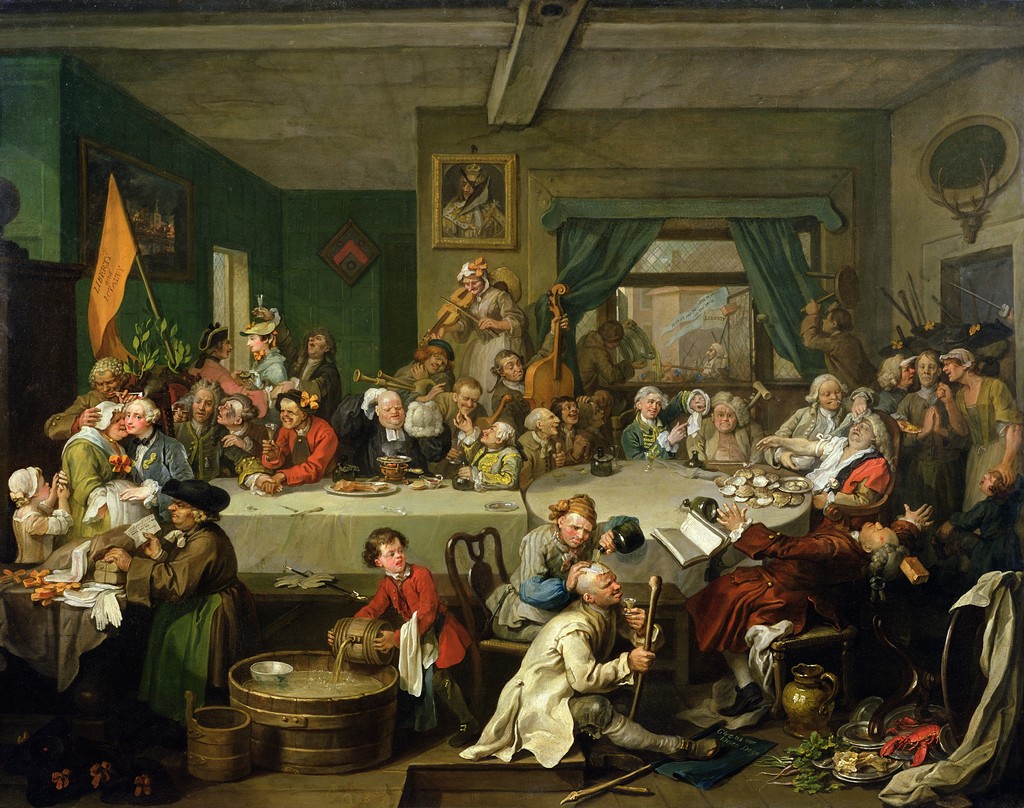Sin City. The moral cautionary tales as a somewhat more narrative and less complex representation than say Bruegel or Bosch though there is more sophistication than the often caricaturial elements would imply; misunderstood, these, over time become trivialized until they filter down into pop culture through such seemingly innocuous work like Norman Rockwell. Hogarth was well schooled in the Old Testament and there is something of the theme of the transitory nature of human existence in the material sphere and drunkenness and the individual’s path to the Garden of Eden, or a temporal vacation from mundanity, completely brought to a halt through the temptation of the opposite force in human nature winning. The individual mastering the 248 bodily parts finds itself well short of that lofty goal….

—An Election Entertainment by William Hogarth—Read More:https://www.artfinder.com/work/an-election-entertainment-william-hogarth/
(see source at end for last image)…glasses and broken clay pipes. In the foreground a drunken man, said to be Hogarth’s friend Dr. Ranby,unsteadily clings to the back of a chair and pours a bottle of wine onto the bald head of the prostrate figure of the prize-fighter James Figg. On the far right a politician in a huge periwig (possibly Hogarth’s friend Ebenezer Forrest) sets fire to his ruffle instead of his pipe, seated next to him a man in a tie wig is about to be sick into the fireplace and complacently ladling punch and smoking a pipe on the far side of the table is the parson Dr Cornelius Ford, a reprobate cousin of Dr. Johnson. Behind him is a noisy man waving his glass in the air, said to be John Harrison a tobacconist, the lawyer sitting with his wig askew on Ford’s right is Kettleby ‘a vociferous bar Orator’ and the glum, deaf man in a white turban is a bookbinder named Chandler who worked for Hogarth. On the extreme left a man has fallen asleep with his mouth open in a tilted back chair, hats and discarded wigs hang on the wall, while on the floor is a pile of empty bottles, broken pipes and an overflowing chamber pot.

—What to make of this antic 18th Century painting? Thirteen women, the same number as attended the Last Supper, are seen in various states of inebriation. Two are fighting, several are toasting and guzzling, and one appears to have descended into lascivious reverie. The woman with the crucifix around her neck vomits on the one who has passed out on the floor. The two in the center have a more serious mien, perhaps engaging in earnest character assassination while they continue to dip into the bowl. Like Christmas wassails, there is something ironic in the revelers’ depravity. After all, they’re well dressed, the setting is luxurious, with a male servant peeking in at the door, and whatever the holiday or occasion it might be, we doubt they intended for it to get this way.
A Midnight Modern Conversation, an anonymous 18th Century oil painting in the style of William Hogarth.—Read More:http://talltchr.blogspot.ca/
…In showing all the degrees of drunkenness, Hogarth was passing comment on his opinion of the social behaviour of prominent businessmen and lawyers, for nearly all the figures can be identified (despite Hogarth’s assertion that they were imaginary).Read More:Ref: Paulson – Hogarth’s Graphic Work no. 128 ii of iii.






 COMMENTS
COMMENTS